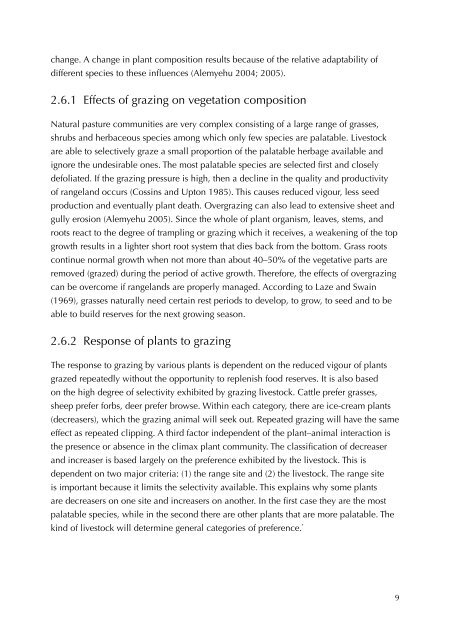Rangeland condition and feed resources in Metema District, North ...
Rangeland condition and feed resources in Metema District, North ...
Rangeland condition and feed resources in Metema District, North ...
You also want an ePaper? Increase the reach of your titles
YUMPU automatically turns print PDFs into web optimized ePapers that Google loves.
change. A change <strong>in</strong> plant composition results because of the relative adaptability of<br />
different species to these <strong>in</strong>fluences (Alemyehu 2004; 2005).<br />
2.6.1 Effects of graz<strong>in</strong>g on vegetation composition<br />
Natural pasture communities are very complex consist<strong>in</strong>g of a large range of grasses,<br />
shrubs <strong>and</strong> herbaceous species among which only few species are palatable. Livestock<br />
are able to selectively graze a small proportion of the palatable herbage available <strong>and</strong><br />
ignore the undesirable ones. The most palatable species are selected first <strong>and</strong> closely<br />
defoliated. If the graz<strong>in</strong>g pressure is high, then a decl<strong>in</strong>e <strong>in</strong> the quality <strong>and</strong> productivity<br />
of rangel<strong>and</strong> occurs (Coss<strong>in</strong>s <strong>and</strong> Upton 1985). This causes reduced vigour, less seed<br />
production <strong>and</strong> eventually plant death. Overgraz<strong>in</strong>g can also lead to extensive sheet <strong>and</strong><br />
gully erosion (Alemyehu 2005). S<strong>in</strong>ce the whole of plant organism, leaves, stems, <strong>and</strong><br />
roots react to the degree of trampl<strong>in</strong>g or graz<strong>in</strong>g which it receives, a weaken<strong>in</strong>g of the top<br />
growth results <strong>in</strong> a lighter short root system that dies back from the bottom. Grass roots<br />
cont<strong>in</strong>ue normal growth when not more than about 40–50% of the vegetative parts are<br />
removed (grazed) dur<strong>in</strong>g the period of active growth. Therefore, the effects of overgraz<strong>in</strong>g<br />
can be overcome if rangel<strong>and</strong>s are properly managed. Accord<strong>in</strong>g to Laze <strong>and</strong> Swa<strong>in</strong><br />
(1969), grasses naturally need certa<strong>in</strong> rest periods to develop, to grow, to seed <strong>and</strong> to be<br />
able to build reserves for the next grow<strong>in</strong>g season.<br />
2.6.2 Response of plants to graz<strong>in</strong>g<br />
The response to graz<strong>in</strong>g by various plants is dependent on the reduced vigour of plants<br />
grazed repeatedly without the opportunity to replenish food reserves. It is also based<br />
on the high degree of selectivity exhibited by graz<strong>in</strong>g livestock. Cattle prefer grasses,<br />
sheep prefer forbs, deer prefer browse. With<strong>in</strong> each category, there are ice-cream plants<br />
(decreasers), which the graz<strong>in</strong>g animal will seek out. Repeated graz<strong>in</strong>g will have the same<br />
effect as repeated clipp<strong>in</strong>g. A third factor <strong>in</strong>dependent of the plant–animal <strong>in</strong>teraction is<br />
the presence or absence <strong>in</strong> the climax plant community. The classification of decreaser<br />
<strong>and</strong> <strong>in</strong>creaser is based largely on the preference exhibited by the livestock. This is<br />
dependent on two major criteria: (1) the range site <strong>and</strong> (2) the livestock. The range site<br />
is important because it limits the selectivity available. This expla<strong>in</strong>s why some plants<br />
are decreasers on one site <strong>and</strong> <strong>in</strong>creasers on another. In the first case they are the most<br />
palatable species, while <strong>in</strong> the second there are other plants that are more palatable. The<br />
k<strong>in</strong>d of livestock will determ<strong>in</strong>e general categories of preference.̕<br />
9

















